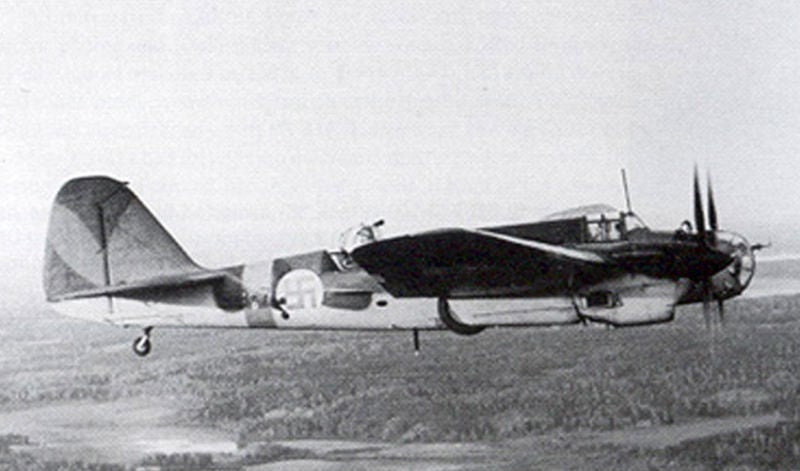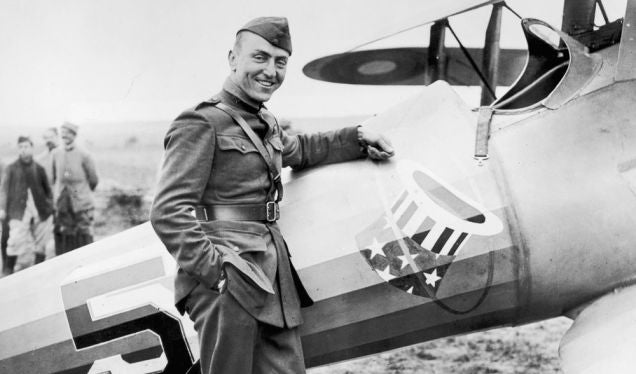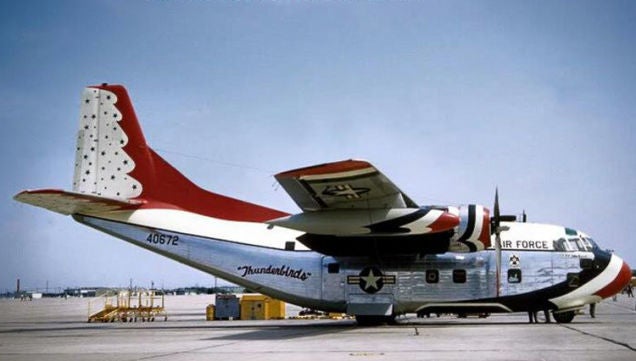 "ttyymmnn" (ttyymmnn)
"ttyymmnn" (ttyymmnn)
10/10/2017 at 12:35 • Filed to: planelopnik history, Planelopnik
 6
6
 8
8
 "ttyymmnn" (ttyymmnn)
"ttyymmnn" (ttyymmnn)
10/10/2017 at 12:35 • Filed to: planelopnik history, Planelopnik |  6 6
|  8 8 |
Welcome to This Date in Aviation History , getting of you caught up on milestones, important historical events and people in aviation from October 7 through October 10.
!!! UNKNOWN CONTENT TYPE !!!

Tupolev SB with Finnish markings
October 7, 1934 – The first flight of the Tupolev SB. Prior to the start of WWII, the design of bomber aircraft began to separate into two general trends. The first was large, heavy bombers capable of flying long long distances with large bomb loads. These bombers packed a punch, but they weren’t particularly fast, and were vulnerable to interception by enemy fighters. The second was the development of medium-sized, two-engine bombers that carried fewer bombs and used their higher speeds as protection from enemy fighters. In 1933, the Soviet Air Force ministry issued a requirement for a new high speed bomber designated Skorostnoi Bombardirovschik (SB) and work on the new aircraft began at the Tupolev design bureau at the Central Aerodynamic Institute ( !!!error: Indecipherable SUB-paragraph formatting!!! ). By the early 1930s, aircraft designers had moved away from fabric-covered wooden frameworks to !!!error: Indecipherable SUB-paragraph formatting!!! aircraft, an arrangement where the metal skin of the aircraft helps to keep the aircraft rigid. Tupolev’s prototype bomber, known as the ANT-40, was the first modern stressed skin aircraft produced by the Russians in large numbers. Tupolev initially created two versions. The first, known as the ANT-40RT, was powered by a pair of !!!error: Indecipherable SUB-paragraph formatting!!! engines and was the first to fly. The second, known as the ANT-40IS, was powered by two Spanish-made !!!error: Indecipherable SUB-paragraph formatting!!! liquid cooled V-12 engines.

Tupolev ANT-40RT in Aeroflot livery
It had a crew of three and a top speed of 280 mph, was armed with four defensive machine guns, and could carry up to 2,200 pounds of bombs. The ANT-40IS served as the production prototype for the Skorostnoi Bombardirovschik , but not before some significant bugs were worked out. The first SBs started rolling off the production line before the testing program had even completed, and the assembly lines faced difficulties because of constant modifications to the production process. Many pilots and maintenance personnel were upset with the early shortcomings of the SB and, when the Russian Commissar for Heavy Industry, Sergo Ordzhonikidze, came for an inspection, the crews covered their aircraft with placards complaining about the problems. !!!error: Indecipherable SUB-paragraph formatting!!! was summoned for an audience with Soviet leader !!!error: Indecipherable SUB-paragraph formatting!!! , where he told the Russian leader that most of the defects were trivial. Stalin replied, “There are no trivialities in aviation; everything is serious and any uncorrected triviality could lead to the loss of an aircraft and its crew.” As production of the SB continued, refinements and improvements slowly made their way into the fleet, and the SB first saw action with the Spanish Republicans during the !!!error: Indecipherable SUB-paragraph formatting!!! in 1936. There, the SB proved to be faster than contemporary fighters, and significantly faster than the older biplane fighters it faced. The SB also saw service in China, Mongolia, Finland, and some captured aircraft were flown by the Germans. Despite its speed, the rapid pace of fighter development rendered the SB obsolete by 1941, and the remaining aircraft were used as transports and cargo aircraft. In all, 6,656 SBs were produced between 1936 and 1941, making it one of the most numerous aircraft of its day. (Photo authors unknown)
!!! UNKNOWN CONTENT TYPE !!!

October 7, 1932 – The first flight of the Stipa-Caproni. The decades of the 1920s-1930s are known as the !!!error: Indecipherable SUB-paragraph formatting!!! , an era marked by an explosion in the popularity of flying and rapid technological advancement. While many designers were content to refine relatively standardized aircraft, others took the opportunity to experiment with radical aircraft that were entirely new. Some of those innovative aircraft were developed into successful production designs, while others, though unsuccessful, paved the way for aircraft of the future. One of the more exotic ideas to come out of this period was the Stipa-Caproni, also known by the reverse name Caproni Stipa. Unlike traditional aircraft of the day, where the wings were attached to a spar running through the fuselage, the Stipa-Caproni featured a large, open, barrel-shaped fuselage with the engine and propeller inside. Created by Italian engineer !!!error: Indecipherable SUB-paragraph formatting!!! and built by manufacturer !!!error: Indecipherable SUB-paragraph formatting!!! , the barrel-like fuselage was a tapered airfoil shape which created a !!!error: Indecipherable SUB-paragraph formatting!!! that compressed the air moved by the propeller and sped it up, putting into practice the principles of fluid dynamics first described by !!!error: Indecipherable SUB-paragraph formatting!!! in 1738. Stipa called his invention an intubed propeller , and he rigorously calculated the shape of both the tube and the propeller, as well as the speed of the propeller, for optimal efficiency.

In 1932, Stipa convinced the Italian government to fund the construction of his unorthodox airplane. Constructed mostly of wood, the aircraft’s elliptical wing passed through the oversized fuselage behind the propeller, and the rudder and elevators were mounted directly behind the tubular fuselage to benefit from the passage of air through the fuselage. Two pilots sat in tandem high atop the aircraft. Test pilots found that the aircraft was extremely stable, almost to the point of being difficult to turn, and the fact that the entire aircraft helped generate lift meant that extremely slow landing speeds were possible. Despite promising test results, the Stipa-Caproni didn’t perform better than contemporary aircraft, and the project was canceled. However, Stipa’s work was influential and widely studied, and some consider his intubed propeller, essentially a
!!!error: Indecipherable SUB-paragraph formatting!!!
, as the precursor to the modern
!!!error: Indecipherable SUB-paragraph formatting!!!
engine.
(Photo authors unknown)
!!! UNKNOWN CONTENT TYPE !!!

October 9, 1999 – The final flight of the Lockheed SR-71 Blackbird. Before the advent of reliable reconnaissance satellites, it was up to aircraft to perform the often dangerous job of spying on an enemy. But reconnaissance aircraft of the time remained vulnerable to fighters, and a number of American spy planes were shot down as they probed the borders of the Soviet Union. The high-flying !!!error: Indecipherable SUB-paragraph formatting!!! removed much of the danger, but it was still vulnerable to anti-aircraft missiles. In 1957, Lockheed began investigating an aircraft that could take over the job of spying on the Soviet Union from the vulnerable U-2. This task became more urgent in 1960 when a U-2 flown by !!!error: Indecipherable SUB-paragraph formatting!!! was !!!error: Indecipherable SUB-paragraph formatting!!! by a surface-to-air missile over the Soviet Union while on a mission to photograph Russian missile sites. Lockheed’s goal was to create a plane that was untouchable by any fighter or missile in existence. In addition to making a plane that flew high and fast, Lockheed also experimented with technologies to reduce the aircraft’s radar signature, the precursor to what is known as !!!error: Indecipherable SUB-paragraph formatting!!! today. The result of Lockheed’s work led to the single-seat !!!error: Indecipherable SUB-paragraph formatting!!! , which first flew in 1962. The A-12 was followed by the !!!error: Indecipherable SUB-paragraph formatting!!! , and though it was not as fast as the lighter A-12, its increased range and more advanced sensors made the Blackbird a more capable aircraft. The SR-71 also added a second crewmember to handle the reconnaissance work, allowing the pilot to concentrate on flying the plane. Powered by two !!!error: Indecipherable SUB-paragraph formatting!!! continuous bleed afterburning turbojets, the Blackbird was capable of speeds up to Mach 3.3 at 80,000 feet. It could not be shot down by the surface-to-air missiles of the day, and it was faster than any contemporary Soviet fighter. The Blackbird took its maiden flight on December 22, 1964 and entered service in 1968. By 1970, Blackbirds were flying two missions a week over enemy territory, most often North Vietnam and Laos, and by the time the SR-71 was retired it had logged 53,490 flight hours. Only one pilot has been lost to an accident. None were lost to enemy fire.

But along with the unsurpassed capabilities of the SR-71 came very high operating costs, and it became a political issue in an era of shrinking budgets and competition for funds. In 1989, the Blackbird was retired from service, even at a time of escalating tensions in the Middle East when it could have performed valuable reconnaissance in the upcoming
!!!error: Indecipherable SUB-paragraph formatting!!!
. When the US government realized that it still had a need for the high-flying spy plane, the SR-71 was updated with real-time data transmission capabilities and reactivated in 1993, in spite of stiff opposition from the US Air Force who said they didn’t have the funds to operate it. The Air Force also claimed that the Blackbird competed for funds with unmanned reconnaissance projects currently under development. After another political battle over funding the aircraft, the SR-71 was permanently retired in 1998, and the last two airworthy Blackbirds were transferred to NASA for research. The book on the Blackbird was finally closed on October 9, 1999 when the last flying aircraft, an SR-71A (61-7980/NASA 844), landed at Edwards AFB in California and was placed in storage with the other NASA Blackbird. All remaining aircraft (as far we know) are now housed at aviation museums around the country.
(US Air Force photo)
!!! UNKNOWN CONTENT TYPE !!!
Short Takeoff
!!! UNKNOWN CONTENT TYPE !!!

October 7, 1995 – The first flight of the Mitsubishi F-2, a fighter built in cooperation between !!!error: Indecipherable SUB-paragraph formatting!!! and !!!error: Indecipherable SUB-paragraph formatting!!! . Based on the !!!error: Indecipherable SUB-paragraph formatting!!! , the F-2 features a larger wing made of composite materials, larger tail plane, larger nose housing a more a powerful radar, a larger air intake and a three-piece canopy. Under the terms of the partnership, advances made in the F-2 were transferred back to Lockheed Martin for use in future US fighters. Produced from 1995-2011, 94 aircraft have been built and serve with the Japan Air Self-Defense Force. (Photo by Cp9asngf via !!!error: Indecipherable SUB-paragraph formatting!!! )
!!! UNKNOWN CONTENT TYPE !!!

October 7, 1963 – The first flight of the Learjet 23, the world’s first light business jet. A true pioneer in the world of business jet (bizjet) aviation, the LearJet 23 originated in Switzerland where it was conceived by !!!error: Indecipherable SUB-paragraph formatting!!! and designed by Hans-Luzius Studer, who had worked previously on the !!!error: Indecipherable SUB-paragraph formatting!!! fighter for Switzerland. The six-passenger bizjet became an instant success, and production was moved to the US where 105 aircraft were produced from 1962-1966. The LearJet has been continuously upgraded and enlarged since, and newer variants remain in production. (Photo by JetPix via !!!error: Indecipherable SUB-paragraph formatting!!! )
!!! UNKNOWN CONTENT TYPE !!!

October 8, 1890 – The birth of Eddie Rickenbacker. America’s top ace of WWI with 26 victories to his credit, Rickenbacker received the !!!error: Indecipherable SUB-paragraph formatting!!! seven times, the French !!!error: Indecipherable SUB-paragraph formatting!!! and !!!error: Indecipherable SUB-paragraph formatting!!! , as well as the !!!error: Indecipherable SUB-paragraph formatting!!! . Following the war, Rickenbacker tried his hand at auto design and purchased and upgraded the !!!error: Indecipherable SUB-paragraph formatting!!! , operating it from 1927-1945 before selling it to !!!error: Indecipherable SUB-paragraph formatting!!! . Rickenbacker’s most successful business venture came as head of !!!error: Indecipherable SUB-paragraph formatting!!! , which he ran from 1938-1959. Rickenbacker died at age 82 in Zürich, Switzerland, and is buried at Green Lawn Cemetery in Columbus, Ohio. (Photo author unknown)
!!! UNKNOWN CONTENT TYPE !!!

October 9, 2009 – The Centaur module of NASA’s Lunar Crater Observation and Sensing Satellite (LCROSS) crashes on the Moon. In an effort to determine whether or not the polar regions of the Moon contain subsurface frozen water, NASA launched LCROSS along wth the !!!error: Indecipherable SUB-paragraph formatting!!! on June 8, 2009 on an !!!error: Indecipherable SUB-paragraph formatting!!! rocket. LCROSS consisted of a Shepherding Spacecraft that was attached to the spent Centaur upper stage of the Atlas rocket. Once over the southern pole of the moon, the rocket stage was launched into a shaded crater and followed down to the surface by the Shepherding Spacecraft with its sensors. The Atlas stage impacted the crater at approximately 5,600 mph, and while the debris plume was not as large as hoped for, the following spacecraft was still able to confirm the presence of water on the Moon. (NASA illustration)
!!! UNKNOWN CONTENT TYPE !!!

October 9, 1987 – The first flight of the AgustaWestland AW101, a joint venture of the Italian company !!!error: Indecipherable SUB-paragraph formatting!!! and the British company !!!error: Indecipherable SUB-paragraph formatting!!! to produce a medium-lift naval helicopter. Known by Britain, Denmark, Norway and Portugal as the Merlin, the AW101 is powered by three !!!error: Indecipherable SUB-paragraph formatting!!! turboshaft engines and entered service in 1999 in the transport, anti-submarine warfare (ASW) and ship-based utility roles. It now serves with both military and civilian operators of 11 nations. In 1999, the US Navy and Marine Corps initiated the !!!error: Indecipherable SUB-paragraph formatting!!! program to find a replacement for the !!!error: Indecipherable SUB-paragraph formatting!!! used to transport the US president, and the AW101, designated the !!!error: Indecipherable SUB-paragraph formatting!!! , was considered in the competition before being canceled in 2009 after significant cost overruns. (Photo by Cpl Phil Major ABIPP RAF via !!!error: Indecipherable SUB-paragraph formatting!!! )
!!! UNKNOWN CONTENT TYPE !!!

October 10, 1958 – A maintenance support aircraft for the US Air Force Thunderbirds crashes near Payette, Idaho. While headed for McChord Air Force Base in the state of Washington, the !!!error: Indecipherable SUB-paragraph formatting!!! reportedly flew into a flock of Canada geese and crashed, killing five flight crew members and 14 maintenance personnel. The investigation could not definitively say that the crash was caused by bird strikes, but the recent grounding of all C-123s due to a fuel system problem was ruled out as a possible cause. However, the investigation also found that the plane was overloaded, crew rest procedures and been violated, and the pilot’s seat may not have been occupied by a qualified pilot at the time of the crash. The crash remains the most deadly accident in Thunderbirds history. (Photo by John Anderson via !!!error: Indecipherable SUB-paragraph formatting!!! )
!!! UNKNOWN CONTENT TYPE !!!

October 10, 1933 – The bombing of a United Airlines Boeing 247.
On a routine transconitental flight, the passenger plane (NC13304) carrying three crew and four passengers exploded and crashed over rural Indiana, killing all on board. Investigators determined that the cause of the explosion was most likely a nitroglycerin bomb, making the crash the world’s first case of air sabotage. The perpetrator was never found, nor did anyone ever claim responsibility for the bombing.
(Photo author unknown)
!!! UNKNOWN CONTENT TYPE !!!
Connecting Flights
!!! UNKNOWN CONTENT TYPE !!!
!!! UNKNOWN CONTENT TYPE !!!
!!! UNKNOWN CONTENT TYPE !!!
!!! UNKNOWN CONTENT TYPE !!!
!!! UNKNOWN CONTENT TYPE !!!
If you enjoy these Aviation History posts, please let me know in the comments. And if you missed any of the past articles, you can find them all at
!!!error: Indecipherable SUB-paragraph formatting!!!
. You can also find more stories about aviation, aviators and airplane oddities at
!!!error: Indecipherable SUB-paragraph formatting!!!
.
!!! UNKNOWN CONTENT TYPE !!!
 MonkeePuzzle
> ttyymmnn
MonkeePuzzle
> ttyymmnn
10/10/2017 at 12:39 |
|
that early Learjet is so adorable! one passenger window! just wow. it’s amazing to see how far the private/business jet industry has come.
 McMike
> ttyymmnn
McMike
> ttyymmnn
10/10/2017 at 12:44 |
|
Bill Leer named a daughter ‘Shanda.’
Dad joke level: Expert
 WilliamsSW
> ttyymmnn
WilliamsSW
> ttyymmnn
10/10/2017 at 12:47 |
|
Caproni made the Short Brothers look too conventional. They made plenty of weirdness.
Nice work getting all the way through an SR-71 post without mentioning the Ultimate Ground Speed Check. :)
 ttyymmnn
> WilliamsSW
ttyymmnn
> WilliamsSW
10/10/2017 at 12:47 |
|
Maybe I should add a link?
Nah.
 WilliamsSW
> ttyymmnn
WilliamsSW
> ttyymmnn
10/10/2017 at 12:49 |
|
I briefly considered it in my reply and came to the same conclusion.
 ttyymmnn
> McMike
ttyymmnn
> McMike
10/10/2017 at 12:52 |
|
Crystal Chanda (she goes by Chanda), but yes, he was a character.
 ttyymmnn
> WilliamsSW
ttyymmnn
> WilliamsSW
10/10/2017 at 12:52 |
|
You’re a good man, Charlie Brown.
 McMike
> ttyymmnn
McMike
> ttyymmnn
10/10/2017 at 12:54 |
|
Bet you $10 on her first day of school when the teacher took roll call Shanda didn’t correct her and started going by “Crystal.”